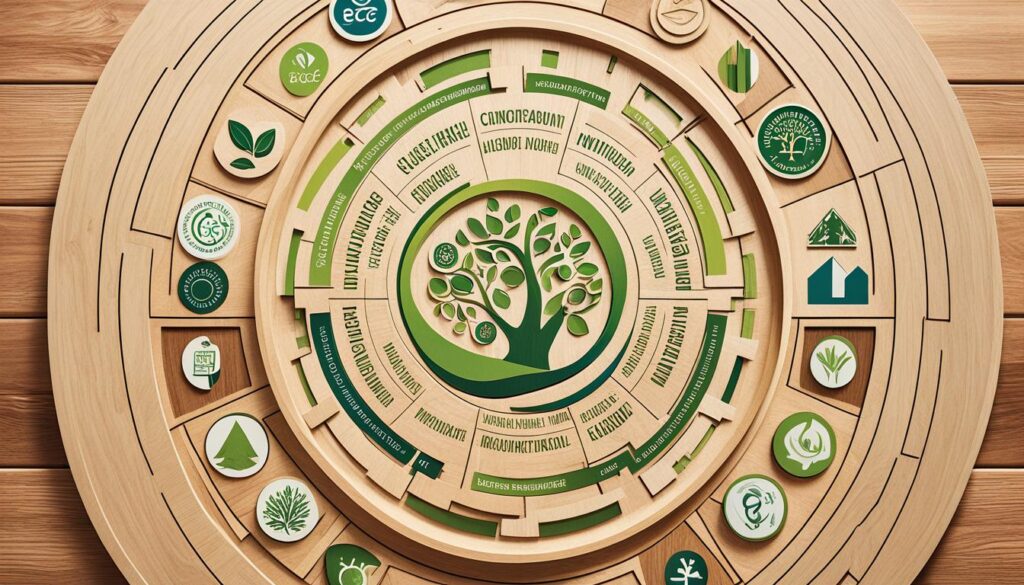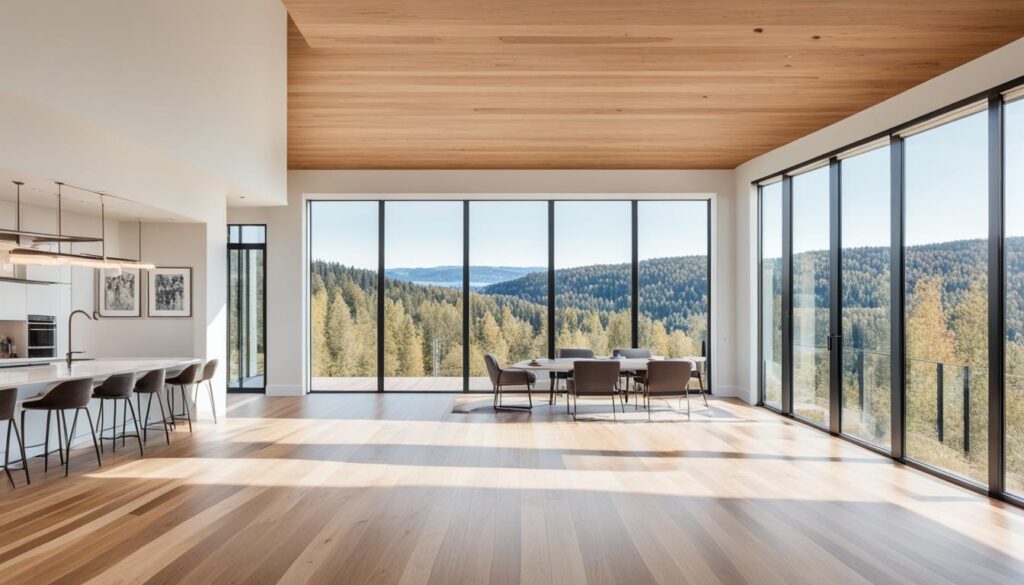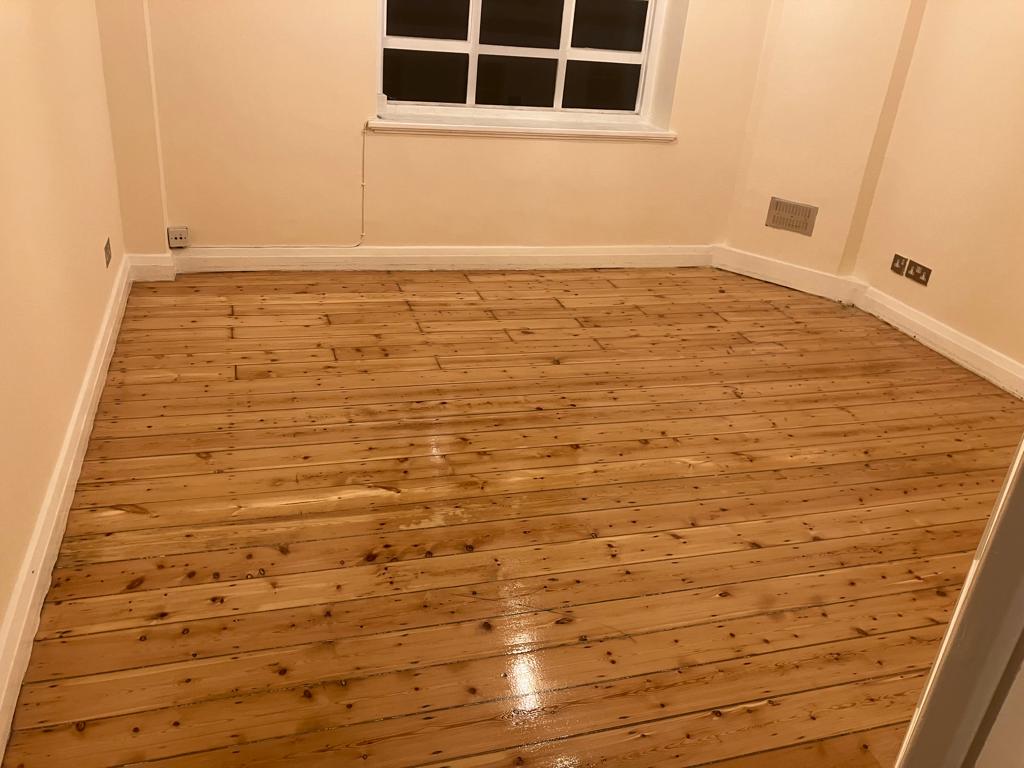Sustainable wood floors are a popular choice in modern interior design, thanks to their eco-friendly attributes. With an increasing emphasis on sustainability, many homeowners and designers are opting for renewable floor materials that align with green building practices. Wood flooring provides a perfect solution, offering not only aesthetic appeal but also environmental responsibility.
Wood floors are sourced from sustainably managed forests, making them an eco-conscious choice. They are considered one of the most sustainable flooring options available, thanks to the renewable nature of wood and the responsible practices employed in its production. By incorporating sustainable wood floors into modern interiors, designers can create beautiful spaces that prioritize both style and environmental consciousness.
Key Takeaways:
- Eco-friendly hardwood flooring is a sustainable option for modern interiors
- Renewable floor materials such as wood contribute to green building practices
- Environmentally responsible wood floors align with sustainability goals
- Sustainable wood floors offer a range of design options for eco-conscious interiors
- Choosing sustainable flooring solutions promotes a healthier planet
Environmental and Structural Benefits of Using Wood Cladding as an Exterior Building Material
Wood cladding is a sustainable building material that offers numerous environmental and structural benefits. It acts as a carbon sink, absorbing carbon dioxide from the environment and reducing carbon emissions. Wood has low embodied energy, requiring minimal energy for production and installation compared to other building materials. It also has superior dimensional stability, allowing it to withstand exposure to the elements. In addition, wood is a renewable resource that can be recycled and biodegraded, making it a more eco-friendly choice for exterior cladding.
The Carbon Sink Effect
Wood cladding plays a crucial role in mitigating climate change by acting as a carbon sink. As trees grow, they absorb carbon dioxide from the atmosphere through photosynthesis and store it in their tissues. When wood cladding is used as an exterior building material, it continues to store the carbon, effectively reducing the amount of CO2 in the atmosphere. This makes wood cladding a sustainable choice that helps combat climate change.
Low Embodied Energy
Compared to other building materials, wood has a significantly lower embodied energy. Embodied energy refers to the energy consumed during the extraction, production, and transportation of a material. Wood requires minimal energy for processing and can be locally sourced, reducing its carbon footprint. This low embodied energy makes wood cladding an environmentally responsible option for exterior applications.
Dimensional Stability
Wood cladding exhibits excellent dimensional stability, allowing it to withstand harsh weather conditions without warping or cracking. This dimensional stability is attributed to the unique cellular structure and moisture-regulating properties of wood. By choosing wood cladding for exterior applications, building owners can enjoy a long-lasting and visually appealing façade that requires minimal maintenance.

Renewable Resource
Wood is a renewable resource that can be sustainably harvested, ensuring the long-term availability of the material. Responsible forestry practices, such as those certified by the Forest Stewardship Council (FSC), protect forests from overexploitation and promote sustainable logging methods. By selecting wood cladding, builders contribute to the preservation of forests and promote the use of a renewable resource.
| Benefits of Wood Cladding | Environmental Impact |
|---|---|
| Acts as a carbon sink | Reduces carbon emissions and helps combat climate change |
| Low embodied energy | Requires minimal energy for production and transportation |
| Dimensionally stable | Withstands exposure to the elements without warping or cracking |
| Renewable resource | Supports responsible forestry practices and long-term availability |
Benefits of Wood-Based Designs in Interior Applications
When it comes to interior design, incorporating wood-based designs offers a host of benefits. One of the most popular choices is wood flooring, which not only adds a touch of natural beauty but also brings durability and longevity to any space.
Wood flooring is durable, long-lasting, and can withstand everyday wear and tear. Whether it’s a busy family home or a bustling commercial space, wood floors are known for their ability to stand the test of time. With proper maintenance and care, they can maintain their original beauty for decades, making them a wise investment for any interior project.
In addition to durability, wood flooring contributes to better air quality in indoor environments. Unlike carpet or other synthetic flooring materials, wood floors don’t trap dust, pet dander, or allergens. This makes them an excellent choice for individuals with asthma or allergies, promoting a healthier living environment.
Wood also plays a significant role in biophilic design, which aims to incorporate natural elements into indoor spaces to enhance well-being. Biophilic design recognizes our innate connection to nature and seeks to create environments that mimic natural settings. Wood flooring, with its warm tones and natural patterns, helps create a sense of harmony and tranquility, thereby improving mental health and overall well-being.
Moreover, wood floors offer versatility in design. They come in a wide range of species, finishes, and colours, allowing designers to choose the perfect style that complements their interior vision. From rustic charm to sleek modernism, wood flooring can be tailored to suit any aesthetic preference.
Highlighted key benefits:
- Durability and longevity
- Better air quality
- Promotes biophilic design
- Versatile design options
Wood Flooring vs. Other Flooring Materials
Wood flooring offers multiple advantages over other flooring materials. Its durability and ability to improve indoor air quality make it an ideal choice for homeowners and designers seeking a healthier and more sustainable living space.
| Benefits | Wood Flooring | Carpet | Laminate | Tile |
|---|---|---|---|---|
| Durability | ✓ | ✗ | ✗ | ✓ |
| Better Air Quality | ✓ | ✗ | ✓ | ✗ |
| Promotes Biophilic Design | ✓ | ✗ | ✗ | ✗ |
| Versatile Design Options | ✓ | ✓ | ✗ | ✗ |

Certifications for Green Building Initiatives
When it comes to green building initiatives, certifications play a vital role in ensuring sustainability and environmental responsibility. Several renowned certification programs have been established to recognize projects that meet specific criteria for green building practices. Let’s explore three prominent certifications that provide a solid framework for incorporating sustainable wood floors into modern interiors.
FSC Certification
The Forest Stewardship Council (FSC) certification guarantees that wood products come from responsibly managed forests. This certification can be obtained through two types: Chain of Custody Certification, which ensures that the wood used in a product originates from FSC-certified forests, and Forest Management Certification, which verifies sustainable forest management practices. Choosing FSC-certified wood floors for interior design projects promotes the conservation of forests and the protection of biodiversity.
LEED Certification
The Leadership in Energy and Environmental Design (LEED) certification is globally recognized as the most widely used green building certification system. Developed by the U.S. Green Building Council, it evaluates a project’s sustainability across various categories, including energy efficiency, water conservation, and sustainable materials. By incorporating LEED principles into interior design, such as using sustainable wood floors, designers can contribute to creating healthier and more environmentally-friendly spaces.
The Living Building Challenge
The Living Building Challenge is a rigorous certification program promoting sustainable building practices. It focuses on creating regenerative spaces that give more than they take from the environment. The certification covers seven performance areas, including energy, water, and materials. By incorporating Living Building Challenge standards into interior design projects, designers can showcase their commitment to creating spaces that prioritize sustainability, health, and well-being.
These certifications provide designers, architects, and homeowners with guidelines and benchmarks to create sustainable interiors. By choosing green building certifications like FSC, LEED, and The Living Building Challenge, professionals can ensure that their projects align with the highest standards of eco-consciousness and contribute to a more sustainable future.

| Certification | Focus Areas | Benefits |
|---|---|---|
| FSC Certification | Responsible forest management Chain of Custody |
– Conservation of forests – Protection of biodiversity – Assurance of sustainable sourcing |
| LEED Certification | Energy efficiency Water conservation Sustainable materials |
– Global recognition – Promotes healthier spaces – Environmental responsibility |
| The Living Building Challenge | Energy efficiency Water conservation Materials |
– Regenerative spaces – Prioritizes sustainability – Enhances health and well-being |
Durability and Eco-Friendliness of Wood Flooring
Wood flooring is a popular choice for both its durability and eco-friendliness. It is a long-lasting material that can withstand everyday use and requires minimal maintenance. Unlike other flooring options that may need to be replaced more frequently, wood flooring can stand the test of time, making it a cost-effective investment for homeowners and businesses alike.
But durability is not the only advantage of wood flooring. It is also an environmentally responsible choice. Wood is a renewable resource, meaning it can be replenished over time. This makes wood flooring a sustainable option for those who are conscious of their environmental impact. By choosing wood flooring, you are helping to promote the responsible use of natural resources and contribute to a greener future.
The Benefits of Wood as a Renewable Resource
Wood is not only durable but also aesthetically adaptable. It comes in a variety of species, finishes, and colors, allowing for endless design possibilities. Whether you prefer a rustic look or a modern aesthetic, wood flooring can be customized to fit your style and taste. Its natural beauty adds warmth and character to any space, making it a popular choice among interior designers.
Wood flooring is not only a functional choice but also a statement of environmental responsibility. By using wood as a building material, we can reduce carbon emissions and promote the use of renewable resources. It is a sustainable and eco-friendly option that aligns with modern interior design trends.
Furthermore, wood flooring can be treated to withstand moisture, making it suitable for wet rooms such as bathrooms and kitchens. With proper installation and maintenance, wood floors can maintain their beauty and functionality even in high-moisture areas.
By incorporating wood flooring into your interior design, you are not only benefiting from its durability and aesthetic adaptability but also contributing to a more environmentally sustainable space. Wood flooring is a smart choice for eco-conscious individuals who value both style and sustainability.

| Benefits of Wood Flooring | Durability | Eco-Friendliness | Aesthetic Adaptability |
|---|---|---|---|
| Long-lasting and can withstand everyday use. | Reduces carbon emissions and promotes the use of renewable resources. | Comes in a variety of species, finishes, and colors for versatile design options. | |
| Requires minimal maintenance and can be treated for moisture resistance. | Contributes to a greener future and responsible use of natural resources. | Adds warmth and character to any space. | |
| – | – | Withstands moisture in wet rooms like bathrooms and kitchens. |
Importance of Energy Efficiency in Interior Design
Energy efficiency plays a crucial role in interior design. By using sustainable materials and maximizing natural light, interior designers can significantly reduce energy consumption. Energy-efficient lighting, appliances, and HVAC systems help lower utility bills and minimize environmental impact. Proper insulation and the use of natural materials like wood and stone further contribute to energy efficiency. By incorporating energy-efficient design principles, interior designers can create comfortable and sustainable living spaces that promote overall well-being.
The Benefits of Energy Efficiency in Interior Design
1. Reduced Energy Consumption
Using energy-efficient lighting, appliances, and HVAC systems can significantly reduce energy consumption in a home or commercial space. By choosing energy-efficient fixtures and appliances, interior designers can help occupants save on utility bills while minimizing their environmental impact.
2. Lower Carbon Footprint
Energy-efficient interior design choices contribute to lower carbon emissions. By reducing energy consumption, interior designers play a vital role in combating climate change and preserving the environment for future generations.
3. Enhanced Comfort and Well-being
Proper insulation and the use of natural materials like wood and stone not only save energy but also create a more comfortable living environment. Adequate insulation helps maintain consistent temperatures throughout the space, reducing the need for excessive heating or cooling. Natural materials contribute to better air quality and a healthier living environment.
4. Cost Savings
Energy-efficient interior design choices lead to long-term cost savings for homeowners or building owners. Lower energy consumption means reduced utility bills, allowing occupants to allocate resources to other important aspects of their lives or business operations.
By incorporating energy-efficient design principles in their projects, interior designers can create spaces that are not only visually appealing but also contribute positively to the environment and the well-being of occupants.
Maximizing Energy Efficiency in Interior Design
To maximize energy efficiency in interior design, consider the following strategies:
- Choose sustainable materials with low embodied energy, such as reclaimed wood or recycled materials.
- Optimize natural light by incorporating large windows or skylights into the design. Natural light not only reduces the need for artificial lighting but also enhances the overall atmosphere of the space.
- Properly insulate walls, floors, and ceilings to minimize heat loss or gain and maintain a comfortable indoor temperature.
- Select energy-efficient lighting fixtures, including LED bulbs, which use significantly less energy and last longer than traditional incandescent bulbs.
- Consider incorporating smart home technology to regulate energy usage and optimize efficiency. Smart thermostats and automated lighting systems can help reduce energy waste.
By incorporating these strategies, interior designers can create energy-efficient spaces that promote sustainability, comfort, and well-being.

| Material | Embodied Energy | Insulation Properties | Sustainability Rating |
|---|---|---|---|
| Reclaimed Wood | Low | Excellent | Highly Sustainable |
| Bamboo | Low | Good | Highly Sustainable |
| Recycled Glass | Low | Moderate | Sustainable |
| Cellulose Insulation | Low | Excellent | Sustainable |
| Sheep’s Wool | Low | Excellent | Sustainable |
Conclusion
Incorporating sustainable wood floors into modern interiors is an excellent way to promote eco-friendly interior design and environmental responsibility. Wood flooring offers numerous benefits, including durability, aesthetic adaptability, and improved indoor air quality. By considering energy efficiency and using sustainable materials, interior designers can create sustainable living spaces that enhance well-being and contribute to a healthier planet.
Sustainable wood floors are a versatile and stylish choice for homeowners and designers alike, providing both aesthetic appeal and a commitment to environmentally responsible design. With their long-lasting durability, wood floors can withstand the demands of everyday use while requiring minimal maintenance. Plus, their natural beauty and variety of finishes allow for endless design possibilities, ensuring that sustainable wood floors can complement any interior style.
By opting for sustainable wood floors, you not only invest in the long-term value and beauty of your home but also contribute to the preservation of our planet. These eco-conscious wooden floors reduce carbon emissions, promote sustainable living spaces, and support the use of renewable resources. Embracing sustainable wood flooring is a small yet impactful step towards building a more sustainable future. Let your commitment to environmental responsibility shine through in your interior design choices by choosing sustainable wood floors.
Create a space that is not only aesthetically pleasing but also environmentally responsible. With sustainable wood floors, you can enjoy the warmth and charm of natural wood while knowing that you are making a positive impact on the planet. Choose sustainable wood floors for your eco-friendly interior design and embrace a lifestyle that prioritizes sustainability and sustainable living spaces.





